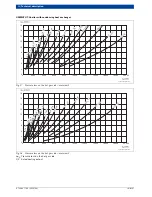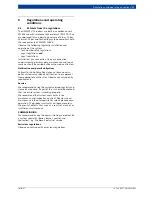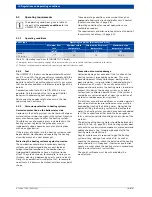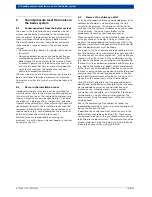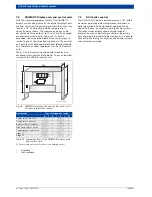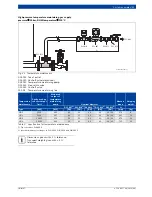
38
|
Regulations and operating conditions
UNIMAT
6 720 807 794 (2013/04)
5.3
Operating requirements
These operating conditions are ensured through an
appropriate hydraulic circuit and boiler circuit control
(hydraulic connection
page 48).
Operating conditions for special applications are
available on request.
The requirements of boiler water quality are also part of
the warranty conditions (
page 39).
5.3.1
Operating conditions
5.3.2
Fuel
The UNIMAT UT-L boilers can be operated with natural
gas E, EL and LPG. The gas quality must comply with the
requirements of the DVGW Code of Practice G 260. To
be able to adjust the gas throughput install a gas meter
that can be checked even in the lower load range of the
burner.
Combustion with fuel oil EL to DIN 51603 is also
possible. Only low-sulphur fuel oil is permitted for
boilers with condensing heat exchangers.
Route away the condensate that occurs in the flue
separately and neutralise it.
5.3.3
Corrosion protection in heating systems
Corrosion protection on the boiler water side
Corrosion in the heating system can be the result of poor
water quality or air-borne oxygen in the system. Negative
pressure allows oxygen to enter the heating system.
Possible causes of oxygen ingress include leaks in the
heating system, regions of negative pressure, an
inadequately sized expansion vessel or plastic pipes
with no oxygen barrier.
If the ingress of oxygen into the heating system cannot
be prevented, we recommend separating the heating
circuit by means of a heat exchanger.
Protecting the heating surfaces against corrosion
The combustion chamber and secondary heating
surfaces can be damaged by heavy dust loads or
halogenated hydrocarbons in the combustion air.
Halogenated hydrocarbons have a highly corrosive
effect. They are contained, for example, in spray cans,
thinners, cleaning & degreasing agents and in solvents.
Design the combustion air supply so that, for example,
no extract air is drawn in from chemical cleaners or paint
shops.
Prevention of corrosion damage
Corrosion damage has occurred if the function of the
heating system is impaired by corrosion. This may
become apparent through blockages, boiling noises,
poor circulation, rust perforations, reduced output or
the formation of cracks. This usually only occurs if
oxygen continually enters the heating water. In order to
prevent this, design the heating system as a sealed
system from a corrosion point of view. If the system is
sealed from a corrosion point of view, the selection of
materials used becomes less significant.
If the system cannot be sealed from a corrosion point of
view, special corrosion protection measures must be
provided by treating the heating water. Alongside the
option of filling the heating system with desalinated
water, the heating water can also have chemicals added
to it. These chemicals either bind the free oxygen or
form a corrosion-resistant coating on the surface of the
material.
The pH value of the heating water should be between 8.2
and 9.5 (
Tab. 23, page 40). If the heating system does
not contain any aluminium components, we recommend
adding chemicals (e.g. trisodium phosphate) to the
heating water to alkalinise it.
Regular maintenance is required to give the heating
system a long, damage-free service life. As well as
checking the pressure, check the pH value of the heating
water and adjust it if required. If corrosion protection
agents are used, check the heating water in accordance
with the manufacturer's instructions.
The use of antifreeze must be authorised by the
manufacturer.
The operating conditions given in table 22
are part of the
warranty conditions
for the
UNIMAT UT-L boilers.
Boiler type
Operating conditions (warranty conditions)
Minimum flow
rate
Minimum return
temperature
Minimum boiler water
temperature
Maximum design
temperature spread
[m
3
/h]
[ °C]
[ °C]
[K]
UNIMAT
UT-L boiler
–
1)2)
1) Sizing the boiler circuit pump
page 53; in burner mode, you must ensure that flow is enabled in the boiler.
2) The heat exchanger pump must also be put into operation for burner mode.
50
70
15–50
Table 22 Operating conditions for UNIMAT UT-L boilers
Содержание UT-L 1
Страница 1: ...Technical guide Heating boiler UNIMAT UT L 6 720 807 794 2013 04 EN ...
Страница 86: ...86 UNIMAT 6 720 807 794 2013 04 Notes ...
Страница 87: ... 87 6 720 807 794 2013 04 UNIMAT ...



